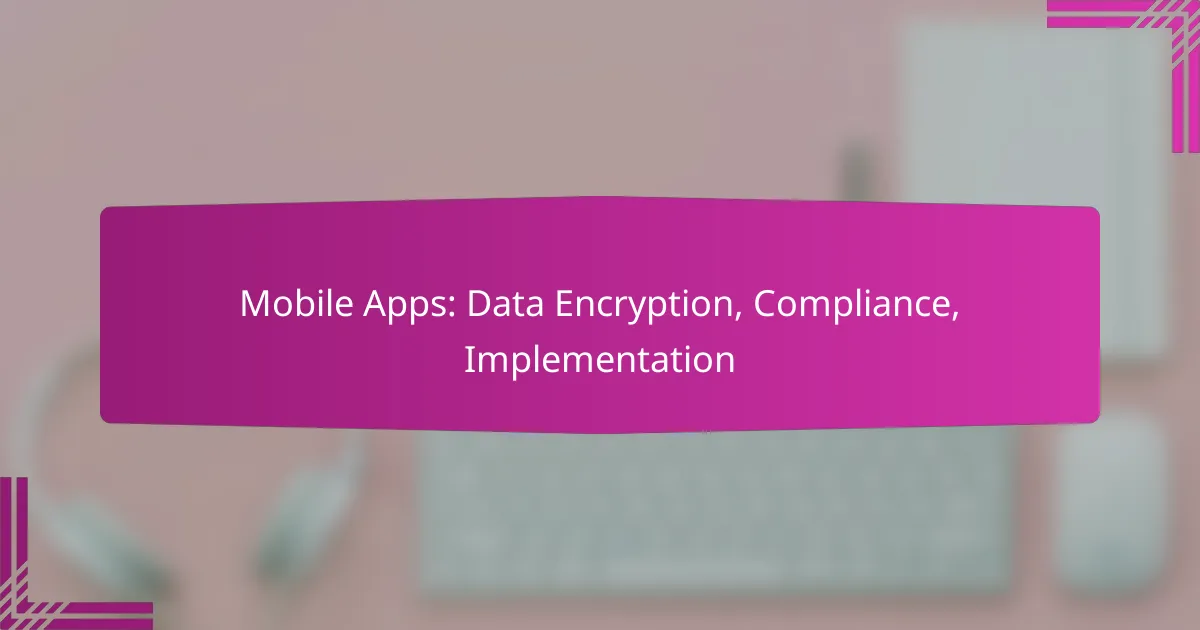In the realm of mobile applications, implementing robust security protocols is essential to safeguard user data and ensure a seamless experience. OAuth 2.0 and OpenID Connect are widely adopted for authorization and authentication, while JWT (JSON Web Token) provides a secure method for transmitting information. By adhering to best practices in these areas, developers can significantly enhance the security of their mobile apps.

What are the best practices for OAuth in mobile apps?
Best practices for OAuth in mobile apps focus on enhancing security while ensuring a smooth user experience. Implementing these practices helps protect user data and prevents unauthorized access to resources.
Use secure redirect URIs
Secure redirect URIs are essential for preventing attacks such as open redirect vulnerabilities. Always register redirect URIs that use HTTPS to ensure that data is transmitted securely. Avoid using generic or wildcard URIs, as they can expose your app to security risks.
For example, if your app’s redirect URI is `https://example.com/callback`, ensure that this exact URI is registered with your OAuth provider. This practice limits the potential for malicious redirection.
Implement state parameters
State parameters are crucial for maintaining the integrity of the OAuth flow. They help prevent CSRF (Cross-Site Request Forgery) attacks by ensuring that the response from the authorization server matches the request made by the client. Always generate a unique state value for each authorization request.
Store the state value in the app’s session or local storage, and verify it upon receiving the response. This simple step can significantly enhance the security of your OAuth implementation.
Utilize PKCE for public clients
PKCE (Proof Key for Code Exchange) is a security extension designed for public clients, such as mobile apps, that cannot securely store client secrets. By using PKCE, you add an additional layer of security to the OAuth authorization code flow.
To implement PKCE, generate a code verifier and a code challenge before initiating the authorization request. This ensures that only the client that initiated the request can exchange the authorization code for an access token, reducing the risk of interception.

How does JWT enhance mobile app security?
JWT, or JSON Web Token, enhances mobile app security by providing a compact and self-contained way to transmit information securely between parties. It ensures that the data is verified and trusted, which is crucial for maintaining user authentication and authorization in mobile applications.
Compact token structure
The compact structure of JWT allows it to be easily transmitted via URLs, HTTP headers, or cookies. A typical JWT consists of three parts: the header, payload, and signature, which are encoded in a base64 format. This compactness makes it efficient for mobile apps that require quick and lightweight data exchanges.
For example, a JWT can be as small as a few hundred bytes, making it suitable for mobile environments where bandwidth may be limited. This efficiency helps improve the overall performance of the app, especially during authentication processes.
Signature verification for integrity
JWTs include a signature that ensures the integrity of the token’s contents. This signature is created using a secret key or a public/private key pair, which allows the receiving party to verify that the token has not been altered. If the token is tampered with, the signature verification will fail, alerting the application to potential security threats.
Implementing signature verification is crucial for protecting sensitive user data. Developers should use strong algorithms, such as HMAC SHA-256 or RSA, to create these signatures, ensuring that only authorized parties can generate valid tokens.
Claims-based access control
JWTs support claims, which are statements about an entity (typically the user) and additional metadata. These claims can be used to implement fine-grained access control by defining what resources a user can access based on their roles or permissions. For instance, a mobile app can issue tokens that include claims indicating whether a user is an admin or a regular user.
By leveraging claims, developers can enforce security policies effectively. It’s advisable to keep claims minimal and relevant to avoid bloating the token, which can impact performance. Regularly reviewing and updating claims based on user roles can help maintain a secure environment.

What are common security protocols for mobile applications?
Common security protocols for mobile applications include Transport Layer Security (TLS), OAuth 2.0 for authorization, and OpenID Connect for authentication. These protocols help protect user data and ensure secure communication between mobile apps and servers.
Transport Layer Security (TLS)
Transport Layer Security (TLS) is a cryptographic protocol that secures communications over a computer network. It encrypts data in transit, preventing eavesdropping and tampering by unauthorized parties. Implementing TLS is essential for any mobile application that transmits sensitive information, such as personal data or payment details.
To effectively use TLS, ensure that your app connects to servers using HTTPS rather than HTTP. Regularly update your TLS certificates and use strong cipher suites to enhance security. Avoid using outdated versions of TLS, as they may have known vulnerabilities.
OAuth 2.0 for authorization
OAuth 2.0 is a widely used authorization framework that allows third-party applications to access user data without exposing passwords. It enables users to grant limited access to their information stored on a server, using tokens instead of credentials. This approach enhances security by minimizing the risk of credential theft.
When implementing OAuth 2.0, ensure that you use secure redirect URIs and validate tokens properly. Be cautious with token storage on mobile devices; consider using secure storage solutions to protect against unauthorized access. Regularly review and update your OAuth scopes to ensure they align with your app’s needs.
OpenID Connect for authentication
OpenID Connect is an authentication layer built on top of OAuth 2.0, enabling clients to verify user identities based on the authentication performed by an authorization server. It provides a standardized way to obtain user profile information, making it easier to manage user sessions in mobile applications.
To implement OpenID Connect, choose a reputable identity provider that supports the protocol. Use the ID token provided to authenticate users and ensure that you validate the token’s signature and claims. Keep user experience in mind by offering seamless sign-in options, such as social logins, while maintaining robust security measures.

What are the risks of using OAuth and JWT?
Using OAuth and JWT can expose applications to several security risks, including token theft, misconfigurations, and insecure storage practices. Understanding these risks is crucial for developers to implement effective security measures.
Token theft through interception
Token theft occurs when an attacker intercepts the access token during transmission. This can happen through various methods, such as man-in-the-middle attacks or insecure network connections.
To mitigate this risk, always use HTTPS to encrypt data in transit. Additionally, consider implementing short-lived tokens and refresh tokens to limit the window of opportunity for an attacker.
Misconfigured redirect URIs
Misconfigured redirect URIs can lead to unauthorized access if an attacker can manipulate the redirect process. If the application accepts any redirect URI, it may inadvertently allow attackers to redirect users to malicious sites.
To prevent this, always validate redirect URIs against a whitelist of approved URLs. Ensure that the redirect URIs are specific and do not include wildcards, which can increase vulnerability.
Insecure token storage
Insecure token storage can expose tokens to unauthorized access, especially in mobile applications. If tokens are stored in easily accessible locations, such as local storage or unprotected files, they can be compromised.
To enhance security, store tokens in secure storage solutions, such as the Keychain on iOS or the Keystore on Android. Regularly review and update storage practices to align with the latest security standards.

How to choose the right security protocol for your mobile app?
Choosing the right security protocol for your mobile app involves assessing the sensitivity of user data, understanding compliance requirements, and considering the app’s architecture. A well-informed decision can help protect user information and ensure regulatory adherence.
Assess user data sensitivity
Begin by identifying the types of data your app will handle. Sensitive data includes personal identifiers, financial information, and health records. The more sensitive the data, the stronger the security protocol you should implement.
For example, if your app processes payment information, consider using protocols like OAuth combined with JWT for secure token-based authentication. This approach helps ensure that user data is encrypted and protected during transactions.
Evaluate compliance requirements
Compliance with regulations such as GDPR in Europe or CCPA in California is crucial when selecting a security protocol. These regulations dictate how user data should be handled and protected, influencing your choice of security measures.
Ensure that your chosen protocol supports necessary compliance features, such as user consent management and data encryption. Regular audits and updates to your security practices can help maintain compliance and protect user data.
Consider app architecture
Your app’s architecture plays a significant role in determining the appropriate security protocol. For instance, a microservices architecture may benefit from using OAuth for managing access tokens across various services.
Additionally, consider the deployment environment. If your app is cloud-based, ensure that the security protocol integrates seamlessly with cloud security features. This can enhance your app’s overall security posture and user trust.



